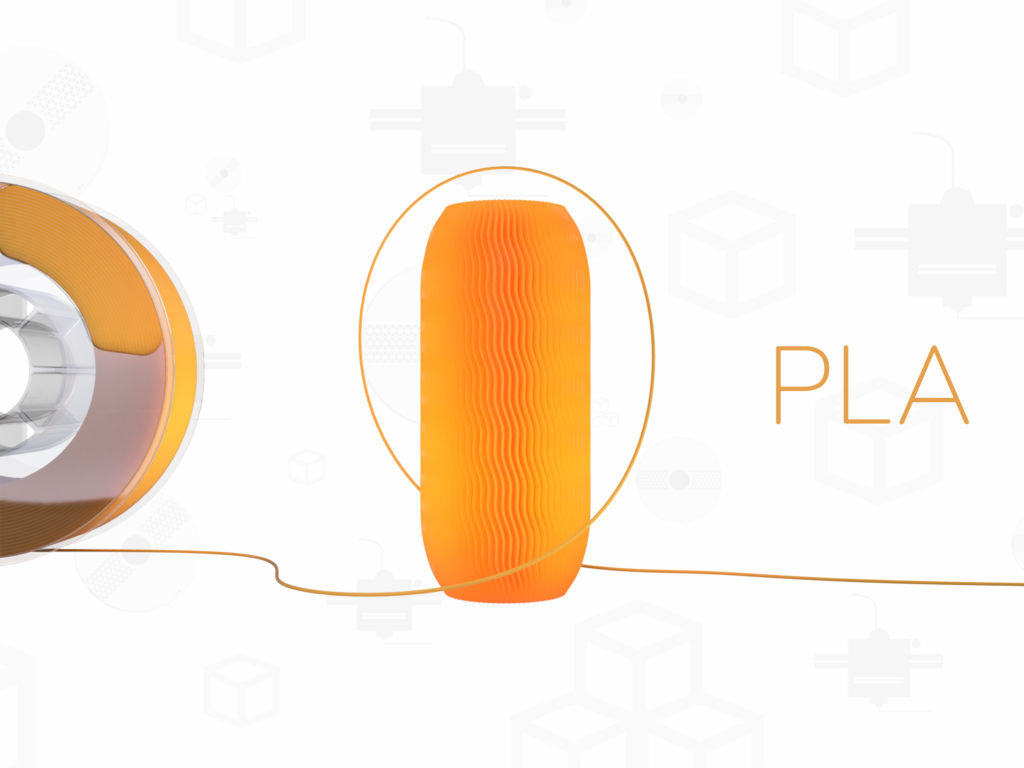Hey there! So, you have decided to finally enter the world of 3d printing. That is awesome, you are going to have a great time, trust us! Although you now have a whole host of materials in front of you and it’s understandable to have a hard time deciding which one to choose for your application.
So, just how many 3D printing materials are there you ask? There is no definite answer. The most common type of 3D printing i.e. FDM/FFF 3d printing can be done with virtually any type of thermoplastic material that can be melted, consistently extruded, and cooled down quickly. Scientists and researchers are constantly coming out with more and more types of polymers and other materials that can be used in 3D printing.
Though there are a few common types of Thermoplastics that are most commonly used in the industry because of their mechanical, thermal, and chemical properties. These include PLA, PETG, Nylon (PA), ABS, and TPU, which are used mostly in consumer-grade parts, and PEEK, PEKK, ULTEM, etc., which are specially engineered polymers used for industrial applications with special needs.
The purpose of this guide is to make you familiar with the most common 3d printing filaments and give you a reference point to compare all the materials, help you answer the question of “What material should I use”
Let’s get started!
For the sake of simplicity let’s leave the engineering grade ‘special’ materials out for now and talk about the most common materials.
PLA
PLA or Poly Lactic Acid is the most widely used material in 3d printing as it is easy to print, biodegradable, and the least expensive of the bunch. It also has an excellent surface finish. You should choose PLA if you want dimensionally accurate assemblies, Prototypes with a focus on surface finishes or design validation, or cosplay and decorative prop items. PLA is generally available in a wide variety of different colours and finishes. It is also available in different kinds of fillers such as wood fill, various metal fills, and even composites with carbon fiber. These composites inherit some of the original properties of the material that is being mixed with PLA. For example, wood fill PLA has a very rough wood-like texture and even smells like wood and metal fills when sanded do get a slight luster to them.
 Now for the reasons you might not want to choose PLA as your material of choice. PLA is a very stiff material, stronger than even ABS and PETG but it is very brittle making it unsuitable for load bearing or heavy mechanical load purposes. Also being biodegradable, not being UV resistant, and having a low temperature of only up to 60C means it is better to not use it in an outdoor environment.
Now for the reasons you might not want to choose PLA as your material of choice. PLA is a very stiff material, stronger than even ABS and PETG but it is very brittle making it unsuitable for load bearing or heavy mechanical load purposes. Also being biodegradable, not being UV resistant, and having a low temperature of only up to 60C means it is better to not use it in an outdoor environment.
 ABS
ABS
ABS is also quite common in 3D printing. Most people have interacted with it in their lives through objects such as LEGO bricks. It is strong, affordable, and lightweight. ABS’s strength, rigidity, and high-temperature resistance (-20 to 90C) make it a good choice for all kinds of engineering products. It should be your choice of materials if you want a part with medium resistance against wear and tear, functional prototypes, automotive hardware, electronics enclosure, etc… If you are 3D printing ABS yourself, it can get a little tricky as ABS like to contract while cooling down which can lead to prints warping out of shape. ABS needs a higher ambient temperature to print so it will be good if your printer has an enclosure. Also, Printing ABS gives out harmful fumes and a nasty odour, so always have ample ventilation in the room. ABS, similar to PLA is available in quite a few varieties of colours and Composites with other materials such as Polycarbonate and Carbon fiber.
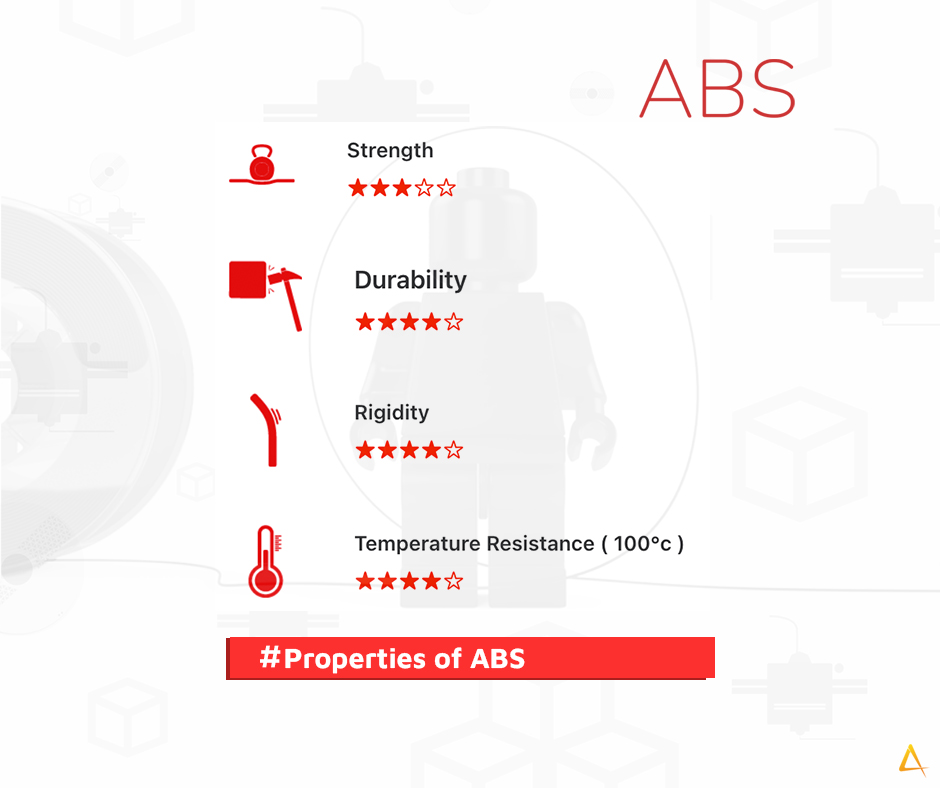 All things considered ABS is a very versatile material. Although since it’s not completely UV resistant, long exposure to the sun should be avoided.
All things considered ABS is a very versatile material. Although since it’s not completely UV resistant, long exposure to the sun should be avoided.
 PETG
PETG
PETG is a modified version of PET or polyethylene terephthalate PET as you might know is the same material that is used to make water bottles and food-safe containers. Glycol which is the G in PETG is added to PET to make it easier to 3D print, it also provides it with properties such as increased transparency. PETG is a highly versatile, tough, temperature resistant (up to 80C) and UV resistant material. It is considerably more flexible than the materials that we have talked about till now, which gives it remarkably high impact strength increasing its durability. It is also known to be a food-safe material. If you want to print PETG, be happy because it is almost as easy as printing PLA. It requires just a little more temperature and less cooling to print. PETG should be your choice if you need parts that are required to be highly wear and tear resistant or are to be used in an outside environment. It’s also great for things like Snap fit components, waterproof parts, and electronic enclosures. This is a great material for long-lasting parts which look great and perform reliably.
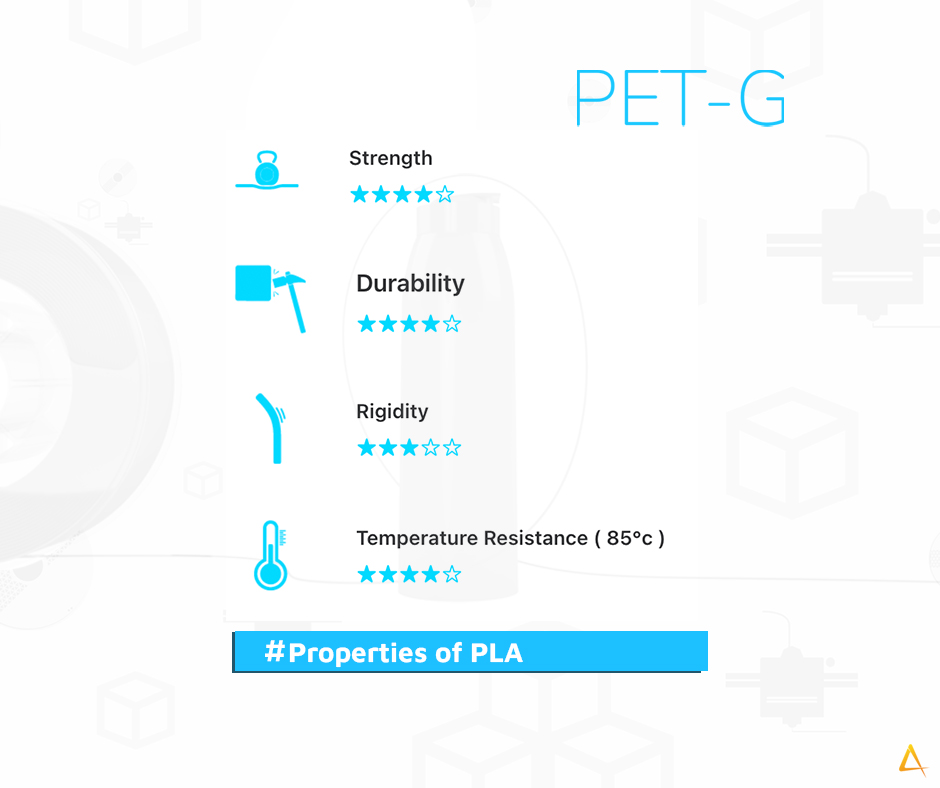 The reason you might not want to choose PETG is that its temperature resistance is lower than ABS so, in applications with high ambient temperature, PETG parts might experience some deformation. Also, keep in mind that PETG parts, if not painted have slight translucency to them.
The reason you might not want to choose PETG is that its temperature resistance is lower than ABS so, in applications with high ambient temperature, PETG parts might experience some deformation. Also, keep in mind that PETG parts, if not painted have slight translucency to them.
 TPU
TPU
Let’s look at TPU now. TPU stands for Thermoplastic Polyurethane. TPU is a flexible material. You can buy TPU in various hardness levels depending on your needs. It is medium strength material, but the durability and impact resistance are magnitudes higher than the more rigid materials.
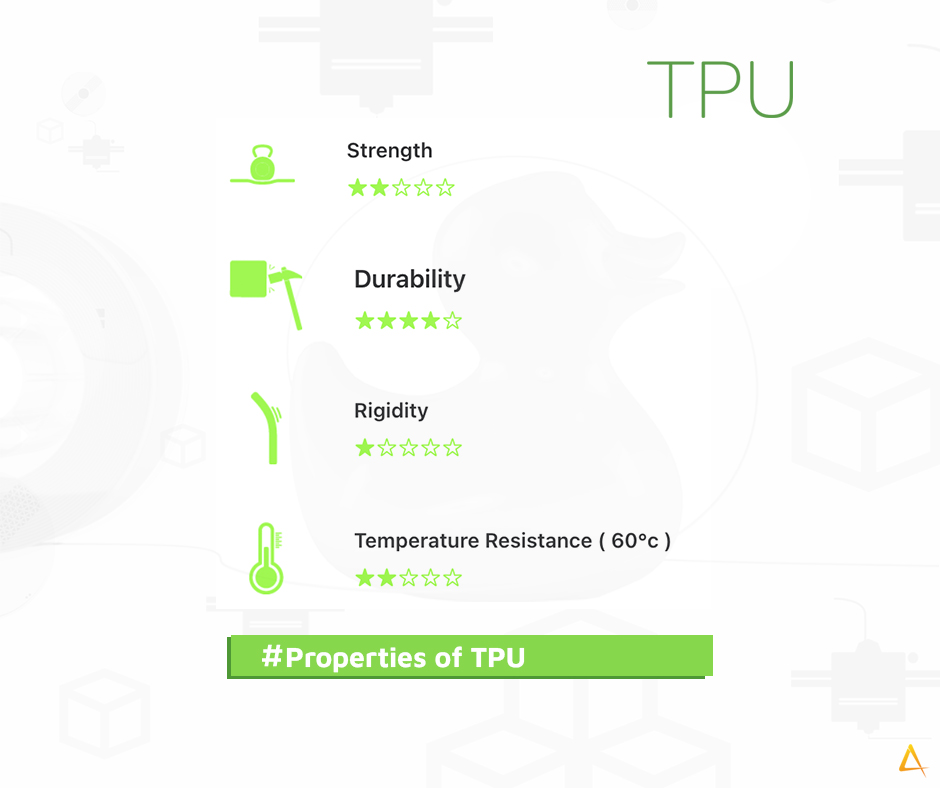 TPU is a great fit for applications like smartphone covers, toys, RC car/drone parts, flexible seals, vibration dampeners, snap-fit parts, and non-skid bases for a lot of daily-use objects. While printing TPU yourself keep in mind that you need to have a dual gear extruder and keep the printing speeds very slow.
TPU is a great fit for applications like smartphone covers, toys, RC car/drone parts, flexible seals, vibration dampeners, snap-fit parts, and non-skid bases for a lot of daily-use objects. While printing TPU yourself keep in mind that you need to have a dual gear extruder and keep the printing speeds very slow.
 NYLON
NYLON
Last but in no way least, let’s talk about Nylon. Nylon (PA) is sort of the king of strength and durability in the consumer 3d printer world. Nylon is a slightly flexible material when put under load giving it surprising levels of durability. Nylon also has the capability of working till up to a temperature of 120C without issues. Nylon is a notoriously difficult material to print though. It needs to be kept away from moisture even then it can absorb even the slightest moisture out of the air and needs to be dried before printing. Some of the available Nylon composites are with Glass fiber, Carbon fiber, and polycarbonate, which add a lot of different mechanical properties to Nylon like increased rigidity and strength.
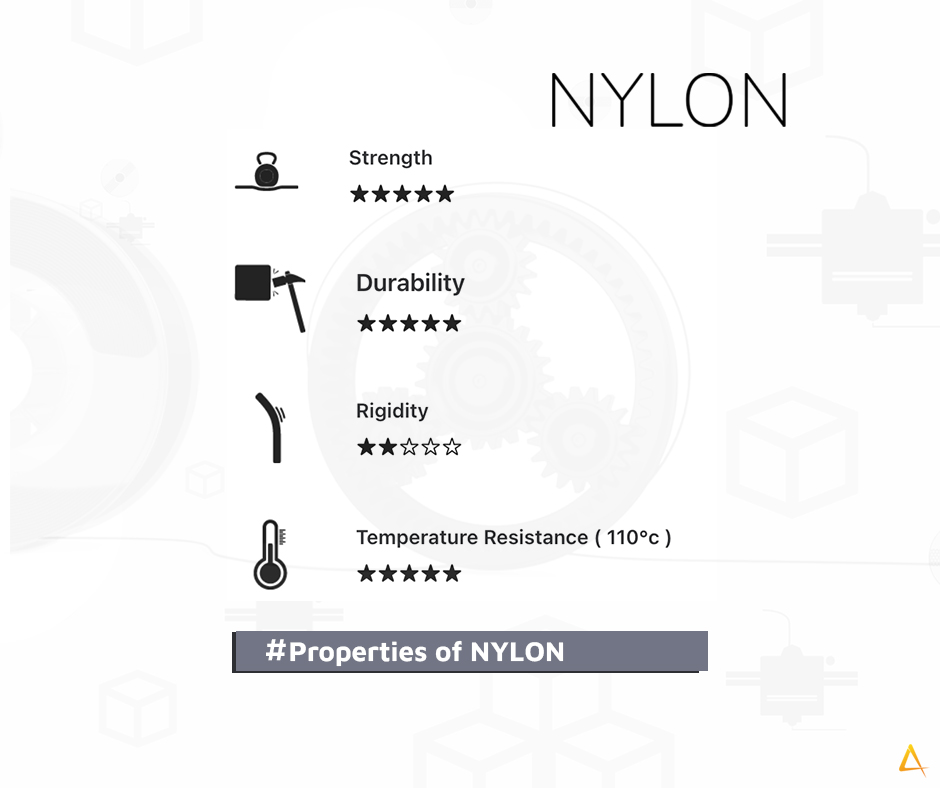 It is an excellent material to print Automotive parts, gears, nuts, bolts, fixtures, and a lot of other Industrial parts
It is an excellent material to print Automotive parts, gears, nuts, bolts, fixtures, and a lot of other Industrial parts
Summing up,
There are so many more 3D printing materials available in the world out there and so many that are still being researched on. We have listed all the common materials that are currently being used in a wide range of applications. There are a few things you should keep in mind when deciding on the material for your project. Firstly, the purpose of the part being printed. If the part is just a design visualizer or a validator which is not going to be tested under load, Materials like PLA are perfect, printing them is easy and inexpensive.
Second thing to keep in mind is to figure out what kind of strength and durability you need. While PLA is a very strong material, it’s really brittle and will fail instantly under medium to high load and will not last as long as ABS and PETG.
Last thing to keep in mind is the Temperature resistance. You should cancel PLA right away if you need to use the part anywhere other than a cool indoor environment. Between ABS and PETG, ABS offers a little bit more resistance to temperature, but if you need a part to work in a high temp environment, you have to go for Nylon.
Some other things to keep in mind would be UV resistance and if your application requires the material to be food safe. So take your time, chart out your requirements and we believe you will choose what’s right for you.
If you are 3D printing for the first time, and are still not sure what material works for your first 3d printing project, reach out to us at Alt Innovate and we would be happy to guide you.
Print Now with us! Has this article excited you, but don’t own a 3D Printer yet download a file from one of the CAD file sourcing places and send it to us for your first 3D printed file.
——————————————————————————————
Like what you read? Follow us on all our social media platforms to see new and exciting news and updates we have to share with everyone. This is a great way to stay up-to-date with the latest trends and exciting projects we do here at Alt Innovate.
